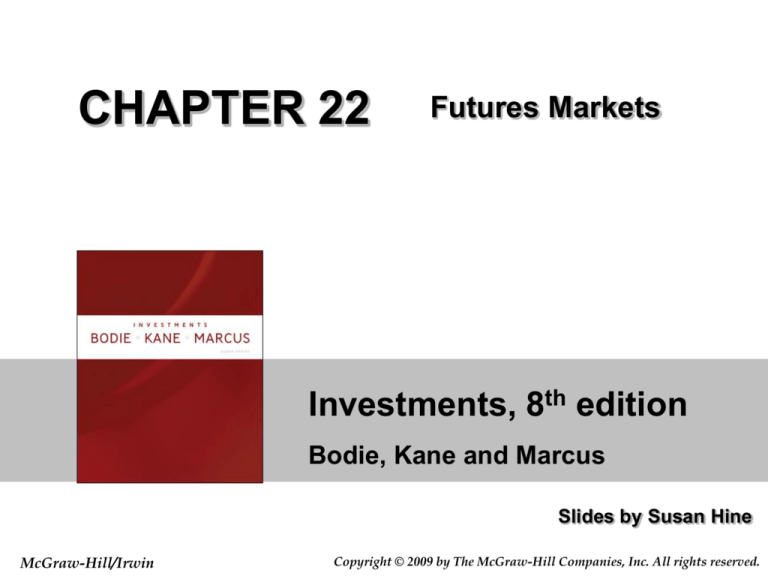
CHAPTER 22
Futures Markets
Investments, 8th edition
Bodie, Kane and Marcus
Slides by Susan Hine
McGraw-Hill/Irwin
Copyright © 2009 by The McGraw-Hill Companies, Inc. All rights reserved.
Futures and Forwards
• Forward - an agreement calling for a future
delivery of an asset at an agreed-upon price
• Futures - similar to forward but feature
formalized and standardized characteristics
• Key difference in futures
– Secondary trading - liquidity
– Marked to market
– Standardized contract units
– Clearinghouse warrants performance
22-2
Key Terms for Futures Contracts
•
•
•
•
Futures price - agreed-upon price at maturity
Long position - agree to purchase
Short position - agree to sell
Profits on positions at maturity
Long = spot minus original futures price
Short = original futures price minus spot
22-3
Figure 22.1 Futures Listings
22-4
Figure 22.2 Profits to Buyers and Sellers
of Futures and Option Contracts
22-5
Table 22.1 Sample of Future Contracts
22-6
Trading Mechanics
• Clearinghouse - acts as a party to all buyers
and sellers
– Obligated to deliver or supply delivery
• Closing out positions
– Reversing the trade
– Take or make delivery
– Most trades are reversed and do not involve
actual delivery
• Open Interest
22-7
Figure 22.3 Panel A, Trading without a
Clearinghouse. Panel B, Trading with a
Clearinghouse
22-8
Margin and Trading Arrangements
Initial Margin - funds deposited to provide capital to
absorb losses
Marking to Market - each day the profits or losses
from the new futures price are reflected in the
account
Maintenance or variation margin - an established
value below which a trader’s margin may not fall
22-9
Margin and Trading Arrangements
Continued
Margin call - when the maintenance margin is
reached, broker will ask for additional margin
funds
Convergence of Price - as maturity approaches the
spot and futures price converge
Delivery - Actual commodity of a certain grade with
a delivery location or for some contracts cash
settlement
Cash Settlement – some contracts are settled in
cash rather than delivery of the underlying
assets
22-10
Trading Strategies
• Speculation – short - believe price will fall
– long - believe price will rise
• Hedging – long hedge - protecting against a rise in price
– short hedge - protecting against a fall in price
22-11
Basis and Basis Risk
• Basis - the difference between the futures
price and the spot price
– over time the basis will likely change and
will eventually converge
• Basis Risk - the variability in the basis that
will affect profits and/or hedging performance
22-12
Figure 22.4 Hedging Revenues Using
Futures, Example 22.5
(Futures Price = $97.15)
22-13
Futures Pricing
Spot-futures parity theorem - two ways to
acquire an asset for some date in the future
• Purchase it now and store it
• Take a long position in futures
• These two strategies must have the same
market determined costs
22-14
Spot-Futures Parity Theorem
• With a perfect hedge the futures payoff is
certain -- there is no risk
• A perfect hedge should return the riskless
rate of return
• This relationship can be used to develop
futures pricing relationship
22-15
Hedge Example: Section 22.4
• Investor owns an S&P 500 fund that has a
current value equal to the index of $1,500
• Assume dividends of $25 will be paid on the
index at the end of the year
• Assume futures contract that calls for delivery
in one year is available for $1,550
• Assume the investor hedges by selling or
shorting one contract
22-16
Hedge Example Outcomes
Value of ST
1,510
1,550
1,610
(1,550 - ST)
40
0
-60
Dividend Income
25
25
25
1,575
1,575
Payoff on Short
Total
1,575
22-17
Rate of Return for the Hedge
( F0 D) S 0
S0
(1,550 25) 1,500
5%
1,500
22-18
General Spot-Futures Parity
( F0 D) S 0
rf
S0
Rearranging terms
F0 S0 (1 rf ) D S0 (1 rf d )
dD
S0
22-19
Figure 22.5 S&P 500 Monthly
Dividend Yield
22-20
Arbitrage Possibilities
• If spot-futures parity is not observed, then
arbitrage is possible
• If the futures price is too high, short the
futures and acquire the stock by borrowing
the money at the risk free rate
• If the futures price is too low, go long futures,
short the stock and invest the proceeds at the
risk free rate
22-21
Spread Pricing: Parity for Spreads
T1
(1
r
d
)
F (T1 ) S0
f
T2
(1
r
d
)
F (T2 ) S0
f
F (T2 ) F (T1 )(1 rf d )
(T 2 T 1)
22-22
Figure 22.6 Gold Futures Prices
22-23
Theories of Futures Prices
•
•
•
•
Expectations
Normal Backwardation
Contango
Modern Portfolio Theory
22-24
Figure 22.7 Futures Price Over Time, in
the Special Case that the Expected Spot
Price Remains Unchanged
22-25






